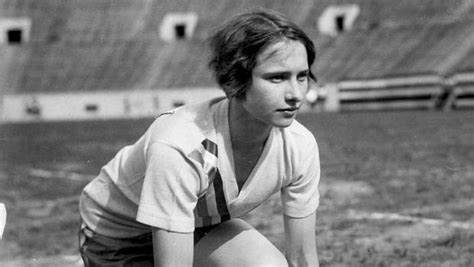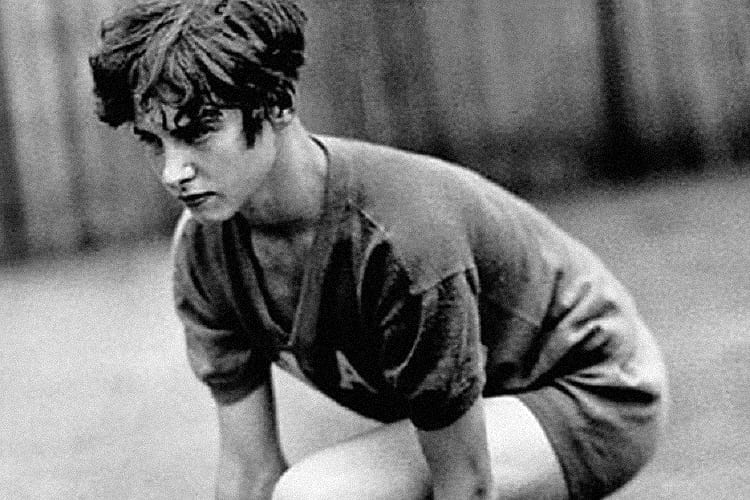Mr. Price took his seat on the L train and waited for the ride home after school. He was a biology teacher in the Riverdale Illinois school system but, for now, he was just glad to be inside. Where it was warm. The train rumbled to life as he wiped the fog away from the glass.
The train was beginning to move now when he spotted one of his students. Betty Robinson. “Smiling Betty”. Such a good natured kid.
Betty had a good 200 yards to go plus a set of stairs, but she was going for it. Running as fast as her legs could carry her, it was too far. She’ll never make this train but there will always be another.
Minutes later a biology textbook plopped into the seat beside him. He looked up in amazement to see Betty Robinson. Smiling. She wasn’t even winded.
Betty knew she was fast, but she never knew how fast. She’d never been been tested but this biology teacher, just happened to be the assistant track coach.

The last bell rang the following day and there stood Mr. Price with a stopwatch. A chalk line was drawn across the tiled floor. Fifty yards up the hallway, Betty Robinson assumed an awkward crouch at her own line, and then came the whistle. Betty was all pumping legs and flailing arms. Her form was ridiculous, but, yeah. She was fast. She crossed the finish line 6.2 seconds after the whistle. 1/10th of a second faster than the women’s indoor world record, for that time.
He asked her if she’d run in an amateur race, just a few weeks out. Betty never knew there were women’s races, but, yes. He didn’t bother to tell her. Helen Filkey would be running too. The woman who held the record.
Coach Price and a senior from the boy’s team taught the sophomore everything they could over the next few weeks. How to bring those arms in. How to anticipate the whistle and how races were won or lost in those first few seconds. Then came race day at Soldier Field. “Smiling Betty” crouched at the blocks, only feet away from the fastest woman in the world. Betty came in second. She was only sixteen.
She joined the Illinois women’s Track & Field club and there she encountered…something new. Today we take women’s athletics for granted, but the 1920s, were a different story. Women were expected to do certain things. Athletics, was not one of them. Even the Olympics, were a man’s world. For the first time Betty met other women, pushing the limits of athletic performance.
The 1928 Summer games in Amsterdam were the first Olympics, to host women’s track and field. Betty came in second in the qualifying round but her times more than qualified her, to go.

There she was, 16 years old and taking the train to New York, to catch the ship to Europe. Training on deck, Betty developed a schoolgirl crush on Johnny Weissmuller, the Olympic swimmer and future star of the Tarzan films. She thought he was the finest specimen of manhood, she had ever seen.
American athletes saw so many disappointments at the 1928 Olympics, but not Betty Robinson. She walked away with gold in the women’s 100 meter sprint, with a new world record, of 12 seconds flat. From a standing start. And silver in the 800 meter relay, didn’t hurt.

Every Olympics has the “it” girl. Simone Biles. Nancy Kerrigan. Nadia Comăneci. Elizabeth Robinson was all that and more in 1928. The first female 100-meter gold medalist in history and, in 1928, a “new kind of girl”.
Betty was a celebrity. There were gifts of diamonds and pearls, Douglas MacArthur gave her a gold bracelet. The International Olympic Committee allowed such things, back then.
Betty returned to Riverdale. She had her first boyfriend. She enrolled in Northwestern but never let up on her training. The 1932 Olympics in Los Angeles were getting closer, every day.

Betty’s cousin Will had a biplane in those days. The two loved to go up in that thing, especially on those hot summer days. She even had a leather helmet, with goggles. Just like Amelia Earhart.
Then came the crash. The man who removed her broken body brought her to Oak Lawn infirmary, because he knew the coroner.
Betty’s arm was broken, her legs destroyed. Her once smiling face badly cut up. The coma lasted, for weeks. She woke up with pins in her legs, now shorter than they used to be. They weren’t even the same length. “I’m sorry” the doctors said, “you may never walk again”.

Betty’s favorite brother-in-law Jim served in the Great War, in France. The gas had taken his health back in 1918. Twenty years later it would take his life, but Jim always had time, for Betty. He would carry the fastest woman in the world in his arms, sometimes waiting for traffic to cross the street and sit on the park bench.
On bad days Betty couldn’t straighten her legs. On good days he would help her stand up. First with an arm held tightly around her shoulder and then a hand, on the small of her back. One day she needed no help at all.
The 1932 Olympics came and went. Betty Robinson watched another woman win the 100 meter sprint.
Stop if you will and run this as a movie, in your mind. Cast the actress of your choice in the role and imagine her coming back from that plane crash, to win Gold in 1936. Now toss it all out because it’s such an outlandish idea, but that’s what happened.
From standing to taking a step and then two, and then walking, and then beginning to jog her broken body began to learn what her old one, already knew. She could never bend down again so she set her sights on the only event, where she didn’t have to. The relay.
The 1936 Olympic games opened in Munich, under the watchful gaze of Reichsführer Adolf Hitler. The growing threat of Nazi Germany hung like dark and threatening clouds, over Europe.

The 1936 Olympics. Where the American track & field athlete Jesse Owens won four gold medals, smashing the Nazi myth of the “Aryan Superman”. Where Wehrmacht Hauptmann (Captain) Wolfgang Fürstner designed and built the Olympic village only to be replaced, two weeks before the games. The Nuremberg laws against racial “impurity” had judged Fürstner to be, half Jewish.
Then came the day of the women’s 400 meter relay. Hitler had to be watching as was Owens, himself. Robinson took the baton at a dead run, neck and neck with a German woman chosen, to leave her in the dust. Betty ran her broken body for all it was worth. 100 meters later she was only behind, by a few steps.
This video is glorious even if it is, in German.
The last American runner took the hand-off. She was closing on the German when her opponent, dropped the baton. It was over. Betty Robinson had been tested and judged, satisfactory. The American team had won Olympic gold.
The XI Olympiad closed on August 16, 1936. Three days later Wolfgang Fürstner, the German patriot whose nation no longer had need of his services ended his life, with a pistol.
Today, Jamaican sprinter Usain Bolt holds the 100 meter record with a time, of 9.58 seconds. Florence Griffith-Joyner is the fastest woman with a time, of 10.49. With all the advantages of the day, the personalized training & nutrition and scientifically designed running gear that’s a scant 1.51 seconds faster than Betty Robinson and her old shoes, and the flapping, loose-fitting clothing required to preserve the feminine modesty, of 1928.



Our track coach never told us about how knee cartilage doesn’t age well.
LikeLiked by 1 person
Oh my. That doesn’t sound good.
LikeLike
Great story ..she is my hero.
LikeLiked by 1 person
It’s hard to get my head around going from that beat up to world class inside of one lifetime, let alone inside of five years. That biplane crash happened in 1931.
LikeLiked by 1 person
I thought she was going to be in a wheel chair after the plane crash…so yea Hollywood would have been hard pressed to come up with a story that actually happened.
LikeLike
Reblogged this on Dave Loves History.
LikeLiked by 1 person
Yet. another AMAZING story!!! Thank you.
LikeLiked by 1 person
I admire this woman, even though I personally, move like a refrigerator.
LikeLike